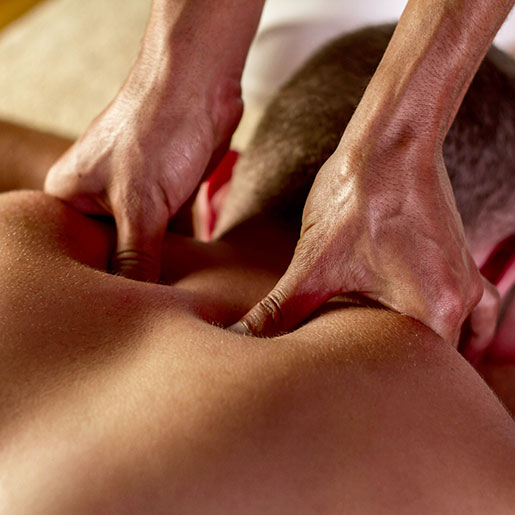Massage is a versatile and effective tool that offers a wide range of benefits, including relaxation, pain relief, and the alleviation of muscle tension, among others. Various types of massage are available, each with its unique characteristics and advantages.

What is Massage Therapy?
Massage therapy is a holistic and therapeutic approach to healing and wellness that involves the manipulation of the body’s soft tissues, typically through the hands of a trained massage therapist. It encompasses a wide range of techniques and methods designed to promote relaxation, alleviate pain and muscle tension, improve circulation, and enhance overall physical and mental well-being.
Key components of massage therapy include:
- Manipulation of Soft Tissues: Massage therapists use various hand movements, pressure, and techniques to manipulate the soft tissues of the body, including muscles, tendons, ligaments, and fascia. These manipulations can help release muscle tension, improve flexibility, and alleviate discomfort.
- Stress Reduction: One of the primary goals of massage therapy is to induce relaxation and reduce stress. Through the use of soothing strokes and techniques, massage can help calm the nervous system, lower stress hormones, and promote a sense of tranquility.
- Pain Relief: Massage therapy is often used to relieve pain, whether it’s related to chronic conditions, injuries, or muscle tension. Techniques such as deep tissue massage, trigger point therapy, and myofascial release can be effective in addressing pain and discomfort.
- Improved Circulation: Massage stimulates blood flow and lymphatic circulation, which can aid in the removal of toxins and waste products from the body. Enhanced circulation can also promote healing and reduce inflammation.
- Enhanced Range of Motion: Massage can increase flexibility and joint mobility by working on the muscles and soft tissues that surround them. This can be especially beneficial for individuals with mobility issues or athletes looking to improve performance.
- Emotional and Mental Benefits: Massage therapy can have positive effects on mental well-being by reducing anxiety, depression, and promoting a sense of relaxation and overall happiness. It can also improve sleep quality.
- Tailored Techniques: Different types of massage exist to address specific needs and goals. For example, Swedish massage is known for relaxation, deep tissue massage targets deep muscle tension, and sports massage is designed to aid athletes in preparation and recovery.
- Complementary Therapy: Massage therapy is often used in conjunction with other medical treatments and therapies to enhance overall health and wellness. It can complement physical therapy, chiropractic care, and other healthcare approaches.
- Professional Training: Massage therapists undergo specialized training and education to develop the skills and knowledge needed to provide safe and effective massages. They are trained to assess individual needs and create customized treatment plans.
Massage therapy is not only a means of physical healing but also a way to promote relaxation and reduce the stresses of daily life. It is widely used to address various health conditions, improve quality of life, and enhance overall well-being. Individuals seeking massage therapy should consult with a licensed and experienced massage therapist to determine the most suitable approach for their specific needs and goals.
The Types of Massage Therapy
Various types of massage are available, each with its unique characteristics and advantages. Here’s a brief overview of some common types of massage and their associated benefits:
- Swedish Massage: Swedish massage is a gentle and soothing massage style that focuses on promoting relaxation and relieving stress. It incorporates long, flowing strokes, kneading, friction, tapping, and gentle stretching. It’s an excellent choice for overall relaxation and stress reduction.
- Deep Tissue Massage: Deep tissue massage involves applying firm pressure to target deeper layers of muscle and connective tissue. It can be effective in releasing chronic muscle tension, addressing muscle knots, and providing relief from specific areas of pain or discomfort.
- Sports Massage: Sports massage is designed to help athletes prepare for and recover from physical activity. It can improve flexibility, reduce muscle soreness, prevent injuries, and enhance athletic performance. It combines various massage techniques tailored to the individual’s sport and training needs.
- Hot Stone Massage: Hot stone massage incorporates smooth, heated stones placed on the body and used by the therapist during the massage. The heat from the stones helps relax muscles, improve circulation, and enhance relaxation. It’s especially beneficial for those seeking deep relaxation.
- Aromatherapy Massage: Aromatherapy massage combines massage techniques with the use of essential oils. The choice of essential oils can be tailored to address specific concerns, such as stress reduction, pain relief, or mood enhancement. The inhalation of essential oil scents can have a calming effect and enhance the overall massage experience.
- Thai Massage: Thai massage is an active and dynamic form of massage that incorporates stretching, compression, and joint mobilization. It aims to improve flexibility, release tension, and promote energy flow throughout the body. It’s known for its invigorating and rejuvenating effects.
- Shiatsu Massage: Shiatsu is a Japanese massage technique that involves applying pressure to specific points on the body. It’s based on the principles of traditional Chinese medicine and is believed to help balance the body’s energy (qi) flow. Shiatsu can relieve tension, improve circulation, and enhance overall well-being.
- Prenatal Massage: Prenatal massage is tailored to the needs of pregnant individuals. It focuses on providing comfort, reducing pregnancy-related discomforts, and promoting relaxation during pregnancy. It can help alleviate back pain, swelling, and stress.
- Reflexology: Reflexology involves applying pressure to specific points on the hands, feet, or ears, which correspond to various organs and systems in the body. It’s believed to stimulate healing and promote overall health. Reflexology can be relaxing and beneficial for reducing stress.
- Trigger Point Therapy: Trigger point therapy targets specific areas of muscle tension or “trigger points” that may refer pain to other areas of the body. It’s effective in addressing localized muscle pain and discomfort.
Each type of massage offers its unique set of benefits, making it important to choose the one that aligns with your specific goals and preferences. Whether you seek relaxation, pain relief, tension reduction, or enhanced well-being, massage therapy can be a valuable tool in achieving these outcomes. It’s advisable to consult with a licensed and experienced massage therapist who can recommend the most suitable massage style based on your individual needs.
Science Shows Massage Therapy for Health Conditions [1]
- Low-Back Pain –Several reviews of research have found weak evidence that massage may be helpful for low-back pain. Clinical guidelines issued by the American College of Physicians in 2017 included massage as an option for treating acute/subacute low-back pain but did not include massage therapy among the options for treating chronic low-back pain.
- Neck and Shoulder Pain – Massage therapy may provide short-term benefits for neck or shoulder pain.
- Osteoarthritis – Only a few studies have examined massage therapy for osteoarthritis, but results of some of these studies suggest that massage may have short-term benefits in relieving knee pain.
- Headache – Only a small number of studies have looked at massage for headache, and results have not been consistent.
- Cancer Symptoms and Treatment Side Effects – With appropriate precautions, massage therapy can be part of supportive care for cancer patients who would like to try it; however, the evidence that it can relieve pain and anxiety is not strong. 2014 clinical practice guidelines for the care of breast cancer patients include massage as one of several approaches that may be helpful for stress reduction, anxiety, depression, fatigue, and quality of life.
- Fibromyalgia – Results of research suggest that massage therapy may be helpful for some fibromyalgia symptoms.
- HIV/AIDS – There is some evidence that massage therapy may have benefits for anxiety, depression, and quality of life in people with HIV/AIDS, but the amount of research and number of people studied are small.
- Infant Care – There is some evidence that premature infants who are massaged may have improved weight gain. No benefits of massage for healthy full-term infants have been clearly demonstrated.
What is The Benefits of Massage Therapy ?

Massage therapy offers a range of health benefits that can be advantageous to individuals dealing with various medical conditions. While it can benefit anyone, massage therapy has shown promise in helping those with conditions such as cancer, heart disease, stomach problems, and fibromyalgia. It’s crucial to communicate any medical issues with your therapist before your first session to ensure a safe and tailored experience. Here are some of the notable benefits of massage therapy:
- Reduces Stress and Anxiety: Massage therapy can induce a feeling of calm and relaxation, which has been shown to reduce stress and anxiety. It is believed to stimulate the parasympathetic nervous system, promoting relaxation and reducing feelings of anxiety associated with the sympathetic nervous system’s “fight or flight” response.
- Improves Sleep: Massage therapy can lower cortisol levels (a stress hormone) and increase serotonin and dopamine levels, which are neurotransmitters known to stabilize mood. This can be particularly beneficial for individuals experiencing sleep disturbances, such as those related to menopause or congestive heart failure.
- Lessens Pain and Muscle Tension: Studies have examined the effectiveness of massage in reducing pain and muscle tension, including acute back pain, neck pain, headaches, and knee pain. While relief may be temporary in some cases, consistent massage therapy sessions have shown better results, particularly when received multiple times per week.
- Improves Immune Function: Some research suggests that regular massages can increase the body’s white blood cell count, potentially enhancing immune function and the ability to combat viruses.
- Relieves Constipation: Abdominal massage has been found to be helpful in relieving constipation, particularly in individuals recovering from surgery.
- Lessens Fibromyalgia Symptoms: Studies have explored the benefits of massage therapy for fibromyalgia, a chronic condition characterized by muscle and joint pain, fatigue, and other symptoms. Over a five-week period, massage therapy has been shown to improve sleep, memory, and mood in individuals with fibromyalgia.
- Relieves Cancer Pain: Individuals undergoing cancer treatments often experience significant physical and emotional challenges. Many have turned to massage therapy to help alleviate cancer-related pain, increase relaxation, and enhance their overall quality of life. While research findings on this topic vary, some studies suggest that massage therapy can have a positive impact on cancer pain and well-being.
It’s essential to note that the effectiveness of massage therapy may vary from person to person, and individual responses can differ. Additionally, massage therapy should be considered as a complementary approach to medical treatment and should not replace essential medical interventions for serious health conditions. Consulting with a healthcare provider and a qualified massage therapist is advisable to determine the appropriateness of massage therapy as part of a comprehensive healthcare plan.
[1] – https://www.nccih.nih.gov/health/providers/digest/massage-therapy-for-health-science